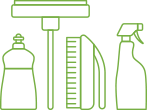Housekeeping
Elements of a Housekeeping Program
A housekeeping program is a process involving more than just cleaning the building. Elements of the program are:
-
Methods to reduce the introduction of dirt into the environment to be cleaned
-
Identification of the cleaning tasks and performance requirements
-
Definition of (and periodic reassessment of) cleaning products, equipment, and procedures
-
Training of cleaning personnel
-
Proper mixing, disposal and storage methods
-
Provisions to protect workers from housekeeping emissions
-
Provisions for timing certain tasks to minimize occupant exposures
-
Inspection and monitoring of the cleaning process

Stewardship Principles
Underlying any housekeeping program should be a set of principles that define the way in which the housekeeping program will be structured and managed. These principles should reflect a recognition that housekeeping services are designed to improve the indoor environment, but have the capacity to degrade it if not performed properly. Useful stewardship principles might include:
-
Clean for health and safety first
, not just for appearance: Appearances can be deceiving. Dirt, film, grime and other contaminants that can't be seen should nevertheless be cleaned because pollution will migrate and diminish indoor air quality in all parts of the building.
-
Protect workers from hazardous working conditions
: Such protections include providing adequate ventilation, personal protective equipment, proper labeling, and proper mixing areas and procedures.
-
Encourage participation and communication:
Cleaning personnel, occupants, and contractors should participate in the development, implementation, and refinement of the program. Occupants should understand how their actions, such as food debris, impact the indoor environment and the cleaning process.
-
Invest in people and equipment:
Cleaning personnel should be well trained. Equipment should be capable of performing the tasks in manner that protects the indoor environment.
-
Recognize the impact of cleaning wastes on the outdoor environment:
Proper handling and disposal of medical waste according to applicable codes and regulations is important. Regulations governing proper disposal of non-medical hazardous materials such as chemical cleaners should also be followed.

Principles to Cleaning for Indoor Air Quality
Keep dirt out
-
Clean outside the building, especially near entry ways, so that less dirt travels into the building.
-
Use barrier mats (walk off mats) on all entry ways, including pedestrian entrances, loading docks, receiving areas, freight entrances, garages into the building. The barrier mats are designed to trap dirt and keep it out of the building. Barrier mats should be long enough that everyone entering the building should be taking five full steps on the mat.
-
As dirt accumulates it migrates further into the building. Use deep and frequent cleaning of carpet in heavily used areas, especially in entryways.
-
Keep dirt and other pollutants away from outdoor air intake.
-
Isolate interior polluting sources using exhaust fans and pressure control.
-
Upgrade HVAC filters and change regularly.
Use maximum extraction and minimum polluting equipment
-
Deep clean carpets at regular intervals.
-
Thoroughly vacuum using high efficiency filtration bags.
-
Use only floor machines with vacuum capability.
-
Avoid carpet treatments with sticky residues.
-
Use lint-free dusting cloths. Avoid dusters that don't capture dust (e.g., feather dusters).
-
Cover top of dust mops with dust cloths to avoid passing dust over the mop.
-
Use toggle-top chemical dispensers or trigger spray directly onto cloth.
-
Vacuum dust skirts on floor machines.
-
Choose low-polluting products.
-
Use MSDS sheets to select "environmentally preferable" products. Minimize volatile organic compounds.
-
Choose products with a moderate PH (between 5 and 9). Minimize use of ammonia, chlorine, and volatile acids, and other products that are corrosive, or reactive with other cleaning products.
-
Minimize use of aerosols or particle cleaners as they may become airborne.
-
Wet or damp materials are a breeding ground for mold. Thoroughly dry material after a water spill immediately. If not dried within 24 hours, the material may have to be discarded.
-
Thoroughly dry after wet process cleaning.
Properly mix and store housekeeping products in a ventilated room or closet
-
Follow protocol for storing any chemical product in a room or closet exhausted to the outside and under negative pressure, with no opening to the return air plenum
Train housekeeping personnel
-
Train all housekeeping personnel before they are allowed to participate in the cleaning operation. One improper application of a chemical product, or failure to use dust-free wipes can contaminate a whole environment and create problems.
-
Training should include developing an appreciation for the role the person plays in creating and maintaining a healthy environment in addition to training on equipment, materials and methods.
Scrutinize contractors
-
Many buildings will use a housecleaning contractor.
-
Negotiate contracts laying forth the principles outlined in I-BEAM to insure that the housekeeping plan supports IAQ in the building.
Monitor results
-
Monitor the results of housekeeping tasks to insure that the building is kept clean as required.
-
Monitor the actual performance of tasks to insure that the tasks are performed as required.
-
Monitor the complaints and reactions of building occupants.
-
Do not tolerate deviations from good practices. Good indoor air quality depends on diligence in following these performance guidelines.
-
Keep good records of what is cleaned, how it is cleaned, and when it is cleaned

Establishing a housekeeping program
Survey the building
A cleaning survey involves an assessment of sources of dirt, and assessment of methods to prevent dirt from entering the building, and an assessment of cleaning needs of individual spaces. Particular attention in the survey should be given to sources of dirt and areas of dirt accumulation. For example:
-
Assess dirt potential of pedestrian traffic, loading docks, receiving areas, and garages.
-
Assess surrounding vegetation, pollen, and proper drainage around building.
-
Assess interior sources such as printing and copying rooms, kitchens, eating and smoking areas, trash needs, storage areas, carpets and furnishings, ceiling tiles.
-
Assess dirt accumulation areas such as horizontal surfaces, corners and edges, furniture, high surfaces, windows and blinds.